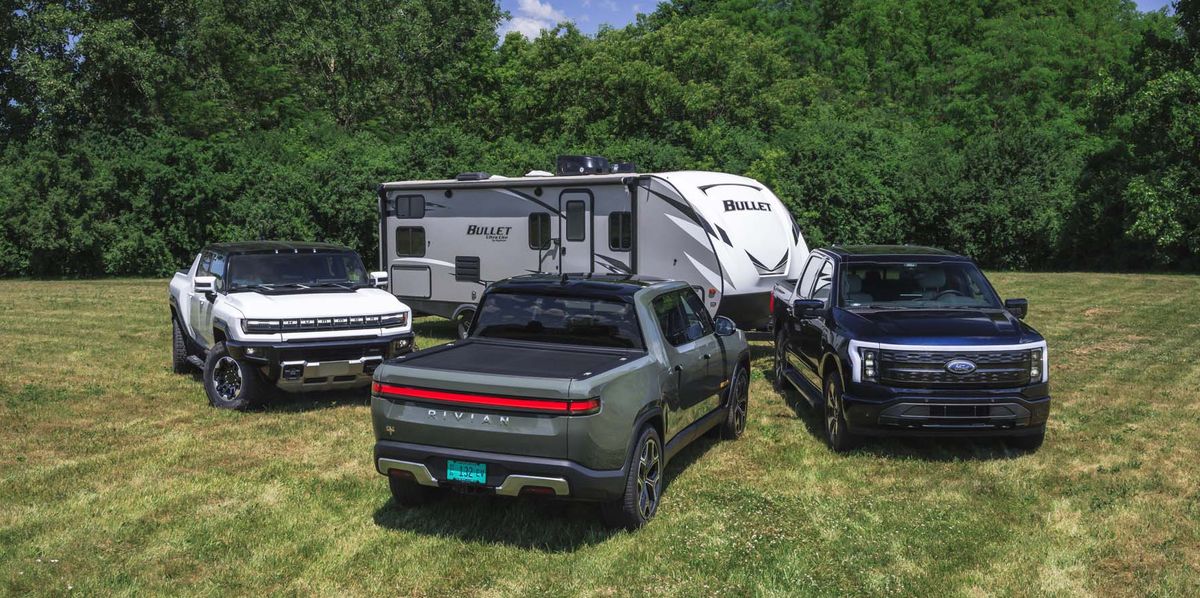Tested: EV Pickups in a Trailer-Towing Test — Hummer, Rivian, F-150 Lightning

From the September 2022 issue of Car and Driver.
Last year, at our inaugural EV of the Year event, there wasn’t a single vehicle that could tow more than 5000 pounds. There are now three such entries: the GMC Hummer EV (7500-pound towing capacity), Ford F-150 Lightning (10,000-pound max), and Rivian R1T (11,000 pounds). To evaluate this emerging electric-towing phenomenon, we hitched each to the same load, a 29-foot camper that weighs 6100 pounds, the sort of trailer a family of four might take on the quintessential summer getaway.
We ran all three trucks on the same 85-degree summer day on the same flat highway loop at 70 mph. Other than the slightly lower speed, which is prudent when piloting between 13,000 and 16,000 pounds of truck and trailer, we conducted this the same way we run our 75-mph highway-range tests, with the automatic climate control set to 72 degrees and running as many miles as we dared before the battery’s state of charge became dire.
Michael SimariCar and Driver
Michael SimariCar and Driver
These new electric pickups are wonderful towing companions, aided by massive horsepower and torque that allow for easy merging with the flow of interstate traffic, and their heavy curb weights (between 6855 pounds for the F-150 and 9640 pounds for the Hummer) lend an impressive stability when lugging a three-ton trailer. But you won’t want to be going far, as a full battery will take you a mere 100 miles in the Lightning, 110 miles in the R1T, and 140 miles in the Hummer. Although the Hummer consumes electricity at the highest rate of the three, its considerably larger battery pack more than makes up for the difference. (As with unladen range, each figure is rounded down to the nearest 10-mile increment here.)
There are a few quirks. EVs can sometimes be fickle to top off; the Lightning was set to charge all the way but instead stopped at 94 percent. However, even boosting its result by the missing 6 percent doesn’t propel it past the next 10-mile increment. Adaptive cruise is available while towing in the Hummer and the Lightning, but not hands-free Super Cruise or BlueCruise, while the Rivian won’t allow the use of adaptive cruise control at all. All of these trucks have integrated trailer-brake controllers, but none is available with larger towing mirrors that would improve visibility at the cost of a bit more aero drag.
Michael SimariCar and Driver
Michael SimariCar and Driver
The Rivian’s higher level of regenerative braking is helpful in slowing a trailer, while the Lightning disables one-pedal drive mode when towing. Selecting Tow mode in the R1T instantly slices its predicted range roughly in half, then adjusts from there based on real-time consumption; the Lightning made a giant downward leap between the first five and 10 miles, from 288 miles predicted to 96; the Hummer’s range-prediction algorithm did the equivalent of putting its fingers in its ears and yelling “na-na-na,” refusing to adjust downward despite dropping an average of 12 miles of predicted range for every five traveled.
The range for all three trucks when towing was less than half as far as when cruising lightly loaded at 75 mph. But the Hummer fared best, we suspect due to its punching the largest hole in the air to begin with—and the Rivian, which fared worst, the smallest—and therefore being relatively less affected by the blocky trailer.

The physics aren’t different from towing with an internal-combustion pickup; in both cases the range will be sliced roughly in half. But in the case of these EVs, that reduced figure can be barely three digits. And low-battery warnings start in at roughly 50 miles to empty, when the battery pack is still nearly half full. Even if you’re accepting of the lengthy recharging stops—which will be even longer due to the need to charge the battery further than when traveling unladen—most highway-adjacent charging doesn’t allow pull-through access. And disconnecting a trailer—especially one like this with a weight-distributing hitch—every couple of hours is a major hassle.




